Dyslexia in Children with Autism: Understanding the Overlapping Challenges
Dyslexia and autism are two distinct neurodevelopmental disorders that often coexist in children. Dyslexia refers to a specific learning disability that affects reading and writing skills, while autism spectrum disorder (ASD) is characterized by difficulties in social interaction, communication, and repetitive behaviors. When these two conditions occur together, they can present unique challenges for children and their families. This article aims to explore the relationship between dyslexia and autism in children, highlighting the overlapping difficulties they face and potential strategies for support.
Children with both dyslexia and autism often experience significant difficulties in acquiring and developing reading and writing skills. Dyslexia affects the ability to decode words, recognize letter sounds, and comprehend written text. Similarly, individuals with autism may struggle with language processing, understanding abstract concepts, and following instructions. These overlapping challenges can make it particularly challenging for children to acquire literacy skills, leading to frustration and a negative impact on their overall academic performance.
One key aspect to consider is the impact of sensory processing difficulties on reading and writing abilities. Many children with autism have sensory sensitivities, such as hypersensitivity to certain sounds, textures, or visual stimuli. These sensitivities can make it difficult for them to focus on reading materials or engage in writing tasks. Additionally, difficulties with fine motor skills, which are common in both dyslexia and autism, can further hinder their ability to write or manipulate letters and words.
Another important consideration is the social and emotional impact of dyslexia and autism. Children with these co-occurring conditions may experience feelings of frustration, low self-esteem, and anxiety related to their difficulties with reading and writing. They may also face challenges in social interactions, as their peers may not fully understand or accommodate their unique learning needs. It is crucial for parents, educators, and healthcare professionals to provide appropriate support and create inclusive environments that foster their overall well-being.
When supporting children with dyslexia and autism, a multidisciplinary approach is essential. Collaboration between parents, teachers, speech-language pathologists, occupational therapists, and psychologists can help develop individualized strategies to address their specific needs. Some effective interventions may include:
1. Multisensory teaching methods: Using visual aids, manipulatives, and hands-on activities can enhance learning and engagement for children with dyslexia and autism.
2. Assistive technology: Utilizing tools such as text-to-speech software, speech recognition programs, or specialized reading apps can support reading and writing skills.

